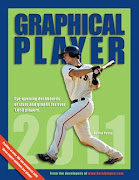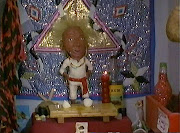
It’s a strange feeling watching your team in a playoff race when you already know the outcome.
Sure there were some frustrating stretches, but did anyone really, truly doubt Cleveland was going to miss the playoffs this season?
I’ve expressed doubts in this forum before, but I always knew in the back of my mind I was watching a great baseball team.
Maybe it was just a fan’s blind faith.
As the Tribe closed out a sweep of the Tigers though, I can’t say I really had any sense of shock or surprise; it was more like a contained joy or excitement. Maybe I should have been more amped up for the Detroit series (which I didn’t miss a minute of), but it’s hard to be on the edge of your seat if you already know the ending. I really couldn’t be prouder of my (i.e. your) team right now knowing where they’ve come from and where they’re going; that in itself is extremely satisfying. So what went down to put Cleveland in this position?
August 1: Cleveland was in the midst of a horrible offensive slump and had an active 4-game losing streak. Detroit was struggling to tread water as well, clinging to a one game advantage in the Central.
September 1: Cleveland’s offense caught fire, the pitching staff gobbled up wins like Pacman, and a rookie infielder from Venezuela was showing everyone why he deserves to wear the number on his back. Detroit was still stuck in neutral as the Tribe built a 5.5 game lead and churned out 8 straight wins.
September 17: Detroit has managed to right the ship just in time for the series finale against Cleveland. The Tigers are bringing a renewed confidence and a 5-game winning streak to the Jake. Cleveland’s lead has held steady at 5.5 games, but faces one last obstacle before they can put the division in a stranglehold.
September 20: Cleveland completes its sweep of Detroit, standing atop a 7.5 game lead after knocking 6 games off their magic ticket to the postseason.
According to the Baseball Prospectus postseason odds, Cleveland has a 99.95680 percent chance of winning their division. Feel free to round up to the nearest tenth, Tribe fans.
Cleveland has compiled a .667 win percentage against teams within their division; the best intra-division record in the majors (Boston comes in second with a .579 WP). The Tribe also went 12-6 against Detroit, scoring more runs (99) against them than any of Detroit’s opponents this season.
I’m not sure what the Tigers were expecting against a team that had gone 30-16 since August 1, but getting tossed to the curb in a three game sweep was probably not what they had in mind. Detroit actually led in all three games, but failed to hold a lead in any of them. To be fair, it’s difficult to hold a lead when your pitchers can’t even keep the ball in the yard. The Tribe’s offense smashed 8 homeruns in three games against the best of the Detroit pitching staff (or what’s left of it, at least). Detroit’s ERA over the series was 5.67, including spectacular failures by Guitar Hero Joel Zumaya (1 IP, 3 ER, BS) and ace-by-default Justin Verlander (5.2 IP, 7 ER).
It’s difficult to single out any one Indian in the field, as each player made a key contribution at some point in the series; it was a true team effort. While the offense and defense were top notch, the bullpen was even better.
Given the obstacles Paul Byrd and Jake Westbrook ran into in Games 1 and 2, the bullpen’s dominance played a pivotal role in deciding the series. Here are the combined splits for the Tribe bullpen in the Detroit series:
| IP | H | BB | K | ER |
| 9.2 | 4 | 1 | 12 | 0 |
Jensen Lewis was among the bullpen stalwarts, bailing out Westbrook in Game 2 with a brilliant 3 inning, 4 strikeout performance. Lewis was pitching in AA Akron at the start of the season and is now primed to make the playoff roster for an AL powerhouse. Raffy Betancourt continued to blow batters away and Joe Bo picked up two impressive, 1-2-3 saves. Borowski now leads the AL with 42 saves. Aaron Fultz also made an appearance in relief. Cleveland’s bullpen has been performing all along, to the tune of a 3.76 season ERA.
The Tribe didn’t just knock down the door to the Central Division; they blew it away with a bazooka.
I hadn’t even mentioned the captain of the pitching staff. If Sabathia doesn’t win the Cy Young this year, I will personally egg Jon Heyman’s house (I don’t actually know if he’s a voter, but I don’t really need a reason for this guy). I realize the Cy Young, like the MVP, has lost most of its credibility as a measure of performance, but I know how much these awards can mean to the players. Who wouldn’t be stoked to win the award for best pitcher in baseball? In that regard, I’d be really disappointed for Charles Carsten if he didn’t take the Cy this season; he’s earned it.
Chances are, if you’re reading this you already know the magnitude of Sabathia’s contributions to the Tribe, so I won’t spend much time explaining his leadership, maturity, toughness, and superb fashion sense. That’s a given. Just for fun though, let’s take a look at the season splits for the Crooked Cap:
| IP | W-L | K | BB | ERA | WHIP | K/BB | CG |
| 234 | 18-7 | 205 | 36 | 3.19 | 1.14 | 5.69 | 4 |
It may be a slim margin, but C.C. has been the best pitcher in the American League this season (and arguably half of last season, but I digress) according to the stats above. If wins are your thing, just imagine how many Sabathia would have with the kind of run support Josh Beckett has gotten this season. Boston has averaged 6.45 runs per game with Beckett on the mound, while Sabathia has gotten 5.10 RPG on the season. Sabathia also went through a stretch where he gave up 2 runs or less in 10 straight starts (July 24-Sept. 3), but picked up just 3 wins due to poor run support. You would hope a stat like that would weigh heavily on the minds of voters, who tend to over emphasize a candidate's win-loss record in the first place.
Sabathia also has an edge over Beckett in win shares, 22-18; implying C.C. has been more valuable to his team than Beckett (obviously a rough metric here, but it’s good for a brief look like this one). Unfortunately, I’m not much of a sabermetrician, but I’m fairly confident that a more in depth analysis of Sabathia’s value as an individual player and to his team would exceed Beckett’s in most cases.
Fun Fact: According to Stats, Inc., the only other left-hander since 1901 to post a better K/BB ratio than Sabathia's mark this season was Randy Johnson, who had a 6.59 ratio in 2004.
C.C. would probably be the first to tell you that the Cy Young doesn’t mean jack compared to a playoff run though. I’m a believer in the old adage, good pitching beats good hitting, and Cleveland’s frontline starters are no exception. Any team with a 1-2 punch as formidable as C.C. and Fausto has more than a reasonable shot at going deep into the playoffs.
I’m extremely superstitious when it comes to baseball (calling the division race just now is about as bold as it gets for me), but Tribe fans have every right to be obscenely excited about their team right now. The Brownies can wait, it’s Tribe Time now.
Random Notes
The STO crew recognized Tribe strength and conditioning coach Tim Maxey as the recipient of the Professional Baseball Strength and Conditioning Coaches Society’s Coach of the Year Award. Congrats Tim, it’s certainly well deserved.
There was an interesting article on the Hardball Times this week on soon-to-be retired ump Bruce Froemming. It featured some insightful anecdotes and a pretty amazing list of events Bruce has been linked to over his 37 year career. Check it out here.
 A few days ago, I got the bright idea of writing about the Tribe’s starting rotation going into the playoffs. Then I realized everyone and Yogi Berra had already discussed/blogged/published their thoughts on the subject. So, after a bad case of writer’s block (among other things) I followed through with the pitching slant anyway. So now I present to you, the esteemed reader, yet another playoff pitching preview.
A few days ago, I got the bright idea of writing about the Tribe’s starting rotation going into the playoffs. Then I realized everyone and Yogi Berra had already discussed/blogged/published their thoughts on the subject. So, after a bad case of writer’s block (among other things) I followed through with the pitching slant anyway. So now I present to you, the esteemed reader, yet another playoff pitching preview. 





















